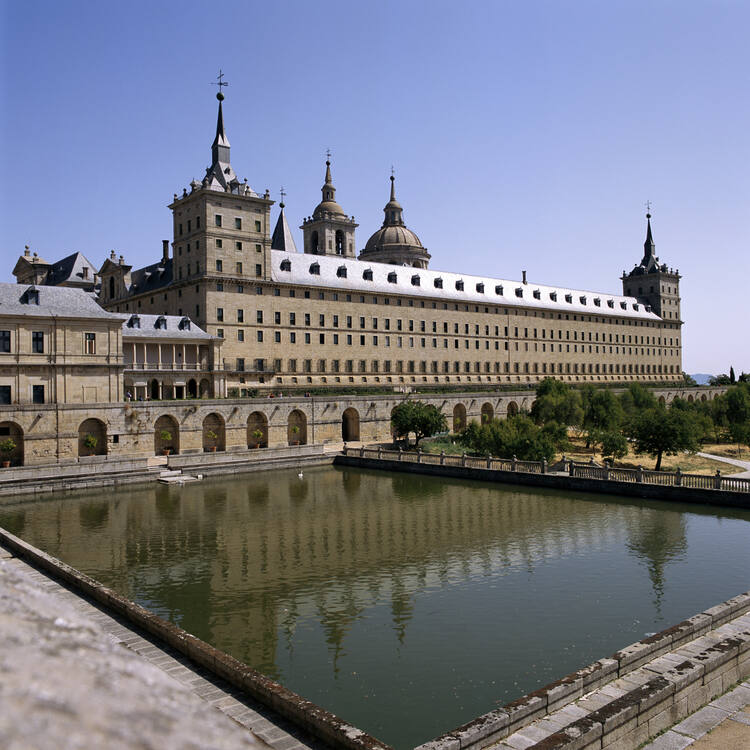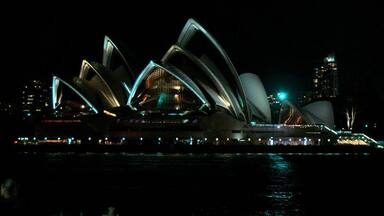Monastery and Site of the Escurial, Madrid
Monastery and Site of the Escurial, Madrid
Built at the end of the 16th century on a plan in the form of a grill, the instrument of the martyrdom of St Lawrence, the Escurial Monastery stands in an exceptionally beautiful site in Castile. Its austere architecture, a break with previous styles, had a considerable influence on Spanish architecture for more than half a century. It was the retreat of a mystic king and became, in the last years of Philip II's reign, the centre of the greatest political power of the time.
Description is available under license CC-BY-SA IGO 3.0
Monastère et site de l'Escurial (Madrid)
Construit à la fin du XVIe siècle sur un plan reproduisant la forme d'un gril, instrument du martyre de saint Laurent, le monastère de l'Escurial s'élève dans un site de Castille d'une exceptionnelle beauté. Rompant par sa sobriété avec le style qui prévalait alors, son architecture exerça une influence considérable en Espagne pendant près d'un demi-siècle. Retraite d'un roi mystique, l'Escurial fut, pendant les dernières années du règne de Philippe II, le centre du plus grand pouvoir politique d'alors.
Description is available under license CC-BY-SA IGO 3.0
دير الإسكوريال وموقعه (مدريد)
شيّد دير الإسكوريال نهاية القرن السادس عشر بناءً على خطة تعكس شكل الأداة المستخدمة لتعذيب القديس لوران والمؤدية إلى استشهاده. ويقوم الإسكوريال في موقع رائع الجمال في محافظة قشتالة. ونظراً لهندسته الرزينة فهو مختلف عن الطراز السائد قبلاً فأثرت هندسته تأثيراً عظيماً في اسبانيا مدّة أكثر من خمسين عاماً. وشكل إسكوريل مقر تقاعد ملك متصوّف وكان في الأيام الأخيرة لحكم فيليب الثاني أعظم مراكز السلطة السياسيّة في تلك الحقبة.
source: UNESCO/CPE
Description is available under license CC-BY-SA IGO 3.0
德里埃斯科里亚尔修道院和遗址
埃斯科里亚尔修道院建于公元16世纪末,位于环境优美的卡斯蒂尔。整个修道院的设计采用长方形格子结构,这样的设计是为了纪念殉难的基督教徒圣劳伦斯,因为他当年就是被这样的刑具折磨致死的。这种简朴且与以往截然不同的建筑风格影响了西班牙半个多世纪。这里还曾是一位神秘国王的隐居之所。到菲利普二世统治后期,这里成为当时最强大的政治力量中心。
source: UNESCO/CPE
Description is available under license CC-BY-SA IGO 3.0
Архитектурный ансамбль Эскориала
В плане этот монастырь, построенный в конце ХVI в. в исключительно красивом месте Кастилии, напоминает решетку-жаровню, на которой, согласно легенде, принял мученическую смерть Св. Лаврентий. Его суровая архитектура, контрастируя с предыдущими стилями, оказывала значительное влияние на испанскую архитектуру в течение следующей половины столетия. Это было убежище для короля-мистика, а в последние годы правления Филиппа II оно стало местом, откуда осуществлялось политическое руководство значительной частью мира.
source: UNESCO/CPE
Description is available under license CC-BY-SA IGO 3.0
Monasterio y sitio de El Escorial en Madrid
Construido a finales del siglo XVI con arreglo a un trazado en forma de parrilla –en memoria del suplicio infligido al mártir San Lorenzo con este instrumento–, el Monasterio de El Escorial se yergue en un paisaje de Castilla de singular belleza. La austeridad de su estilo rompió con las tendencias arquitectónicas imperantes, ejerciendo posteriormente una acusada influencia en la arquitectura española durante más de medio siglo. Lugar de retiro del rey místico Felipe II en un principio, el monasterio fue en los últimos años de su reinado el centro del poder político de este monarca, el más poderoso de su época.
source: UNESCO/CPE
Description is available under license CC-BY-SA IGO 3.0
マドリードのエル・エスコリアル修道院とその遺跡
source: NFUAJ
Escoriaal klooster en omgeving, Madrid
Source: unesco.nl
Outstanding Universal Value
Brief synthesis
Built at the end of the 16th century, the Escurial Monastery stands in an exceptionally beautiful site at the foothills of the Sierra de Guadarrama, north of Madrid. It was the retreat of a mystic king, Philip II, and became in the last years of 'his reign the centre of the greatest political power of the time.
Philip II founded the monastery in 1563 as a votive monument and pantheon to the Spanish monarchs from the Holy Roman Emperor Charles V onwards. Its design, which is complex yet also simple, was created by Juan Bautista de Toledo, Spanish pupil of Michelangelo during the works of the Vatican Basilica, and completed by Juan de Herrera after Toledo’s death.
The royal site includes the monastery, a stone complex of extraordinary dimensions surrounded by formal gardens and the monks’ gardens, the House of Trades, and the Company Quarters where the palace and monastery services were accommodated. In the 18th century, the new Houses of Trades were built, completing the Lonja (the stone esplanade), and, consequently, a small town arose around the monastery, becoming a model of the Enlightenment, accommodating the court as well as the two country villas for Charles III’s sons.
Within the monastery’s massive volume, there is an ensemble of different buildings: the monastery, the church, the royal palace, the school, the seminary, and the royal library, brilliantly organised around eleven main courtyards and three service courtyards. Some say, the design is similar to that of the grill, the instrument used for St Lawrence’s martyrdom. Its austere architecture, a sparsely ornate style, known as “herreriano”, was a break with previous styles, and had a deep influence on Spanish architecture for more than half a century. Notwithstanding, several rooms do have a very rich and sublime decoration. Contemporary writers praised it as one of greatest paradigms of the arts: the “Eighth Wonder”.
The Royal Monastery and Site of St Lawrence of the Escurial is the monument that symbolises the ideological and artistic expression that inspired and represented the Spanish Catholic Monarchy during the Golden Age, between the 16th and 17th centuries, as well as its permanence until the end of the Ancien Régime.
Criterion (i): The Monastery and Site of the Escurial, Madrid, represents a masterpiece of human creative genius, where the great collective work of important artists were subject to the will and orders of the historic figure of King Philip II.
Criterion (ii): The Monastery and Site of the Escurial expresses an important interchange of human values, and symbolises the ideological and artistic expression that influenced developments in architecture, monumental arts, and landscape design during the Spanish Golden Age. The architectural ensemble is an example of the palace convents and their urban and landscape design built by the European Christian monarchies Its final layout of the 18th century makes it one of the most representative examples of the Real Sitio – the courtiers’ residential town – developed by the monarchy as a seat and reflection of its power.
Criterion (vi): The Monastery and Site of the Escurial, Madrid is directly associated with very important historic personalities in European history and the world, such as the Holy Roman Emperor Charles V and all his descendants from the House of Austria and the House of Bourbon who occupied the Spanish throne, in particular Philip II. It embodied, in an exemplary way, the ideology of the society and the austere pomp and ceremony with which its divine and worldly majesty was represented.
Integrity
The inscribed property encompasses an area of 94 ha. The original constructions built during Philip II’s reign – the main building of the Monastery and the Houses of Trades – as well as those built under Charles III’s reign, in the 18th century, which made up the new town that constituted the Royal Site of St Lawrence, remain completely intact. The unified character of the buildings built during Philip II’s reign was preserved two centuries later thanks to the talent of the royal architect, Juan de Villanueva, since this monument was an example of an absolute architectural model for the academicians of the Enlightenment.
The transformation of the majority of pasture lands, that made up the royal woods during the 19th century, and the town’s development in the 19th and 20th centuries have not had an adverse effect on the conservation of the monument or its perceived image. The natural landscape of the estate of the Herrería, the natural surroundings closest to the monument, are under the protection of National Heritage.
Authenticity
The geographical location and the heterogeneous landscape of the monument have been maintained. Both the original constructions built during Philip II’s reign, as well as those built under Charles III’s reign, are conserved fully respecting the design, layout, interplay of open spaces and closed volumes, materials, and the ensemble’s spirit. The formal expression of the monument in itself contributes to keeping this spirit alive.
The functional dynamism of the main building, designed for the coexistence of life in the monastery and the court, is perpetuated today in the compatibility of its present functions: religious – Augustinian Fathers have run the monastery since the 19th century; educational – through the Real Colegio founded by Alphonse XII in 1875; and for cultural research and museum studies.
Protection and management requirements
The general framework for the protection and management of the monuments is mainly established by the law 23/1982 which regulates the Spanish National Heritage Board and includes the Royal Palace – Monastery, the Casita del Príncipe, with its vegetable garden and agricultural land, the Casita de Arriba, the Houses of Trades, and the Queen’s and Infantes’ quarters. The Board is responsible for the protection, conservation, and enhancement of the properties and rights of National Heritage as well as the patronage of the Real Patronato del Monasterio de San Lorenzo de El Escorial.
The ensemble of buildings is still administered by the Consejo de Administración de Patrimonio Nacional (Spanish National Heritage Board), a body which inherited the Crown’s Heritage, and which has under its protection the most important monuments of the Royal Foundation, maintaining its unified character. Given its mandate, the Board is responsible for safeguarding the coherence between the different elements, favouring the use of traditional materials and building techniques depending on each case. To this effect, it carries out intervention and conservation projects in real estate and chattel, including implementing nature conservation plans. The Plan de Protección Medioambiental del Bosque de la Herrería (Environmental Protection Plan of the Herrería Woods) will be the main planning tool to protect the immediate natural surroundings of the property.
Additional regulations offer different degrees of protection and strengthen the conservation of the monument and its surroundings, the latter being one of the most vulnerable aspects due to the threat posed by urban development.
The different properties are listed in the Spanish State’s Heritage Inventory as monuments, historic garden or historic ensemble, depending on the corresponding category of each element.
On a regional level, the Government of the Autonomous Community of Madrid has classified the Royal Site as a Property of Cultural Interest (BIC, Bien de Interés Cultural) under the category of Historic Territory as part of the Cerca Histórica de Felipe II (the surrounding land fenced off by Philip II). The Regional List of Species of Wildlife at Risk also protects trees that are considered to be exceptional.
On a local level, the elements of the property are registered in the Local Authorities´ Protection Inventories.
In terms of territorial planning, the Plan de Ordenación de Recursos Naturales de la Sierra de Guadarrama (Sierra de Guadarrama’s Natural Resources Plan) seeks to guarantee its conservation, preventing random, massive, or disturbing urban development, and to link the conservation of the historical heritage with the conservation of the environment.
The protection and management of the property and its surroundings will continue through a global, integrated, and inter-disciplinary approach in which the methodology of preventive conservation will be included and significance of the architectural ensemble and its surroundings will be protected in balance with the needs and evolution of society.

